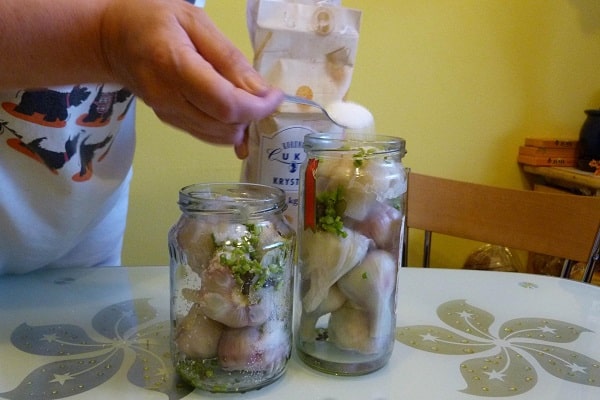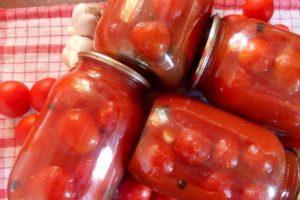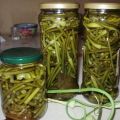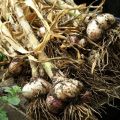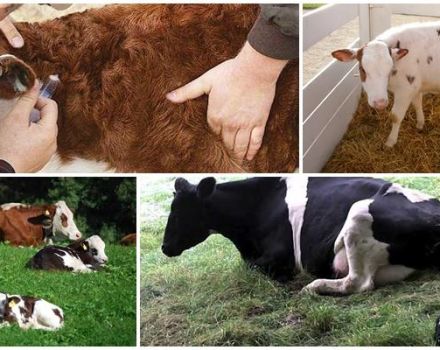Reasons for the blue discoloration of garlic in jars when preserving and pickling cucumbers and tomatoes
Garlic is widely used in the preparation of various supplies for the winter. Sometimes the aromatic vegetable loved by many begins to change its usual light color. It may acquire an atypical bluish or greenish tint. At the same time, the taste characteristics of the product and its aroma are fully preserved. Given the possibility of such changes, it will be useful to know why garlic can turn blue when pickled.
The main reasons why garlic turns blue or green
Scientists from different countries became interested in the color changes of garlic in the marinade a few years ago. In the process of repeated experiments, several important points emerged. Researchers have identified the steps in a complex chemical reaction that causes the product to turn blue:
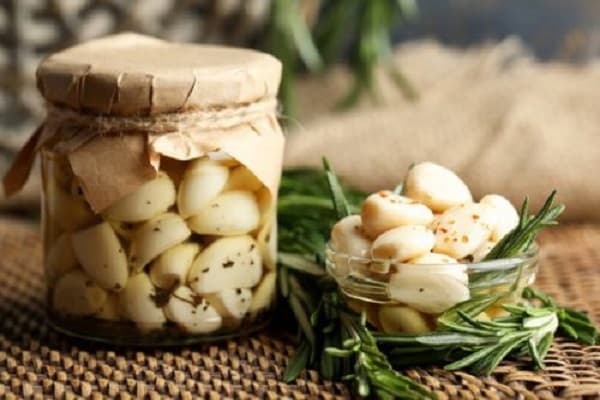
- when the integrity of the teeth is disturbed, the essential oils and enzymes included in its composition participate in active reactions;
- the enzyme alinase causes the decomposition of alliin (a substance that provides a pungent garlic taste);
- as a result of the breakdown of alliin, some essential oils provoke the appearance of sulfates and sulfides;
- the latter form special pigments that lead to the appearance of atypical coloration.
Another common factor in the presence of which a spicy vegetable can turn blue or green after seaming is the presence of considerable amounts of copper in it. This metal tends to degrade in an acidic environment, and provoke the appearance of bluish spots on garlic cloves.
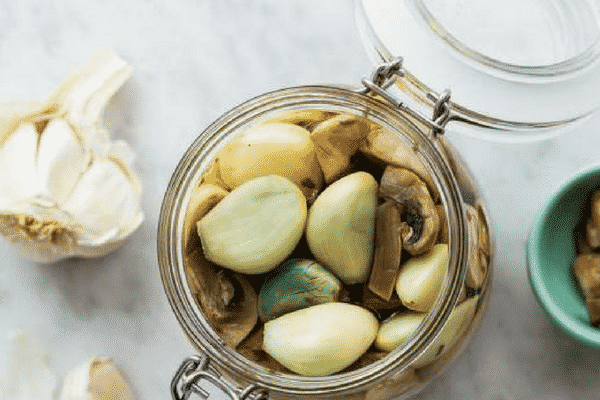
Vegetables also tend to turn blue or green:
- With broken integrity.
- Pre-cooked.
- Incorrectly stored before pickling (if the product has been in the refrigerator for a long time, the alliin content in it increases, and therefore it is recommended to place the garlic in the pantry at a temperature of +18 to + 25 ° C).
- They have a high degree of maturity (young garlic contains a small amount of alliin and essential oil compounds, the presence of which provokes pronounced chemical reactions).
Attentive housewives noticed that foreign (Chinese) garlic is prone to discoloration in tomatoes or in a jar of cucumbers. A domestic vegetable, as a rule, transfers the workpiece without any transformations, completely retaining its usual color and appearance.
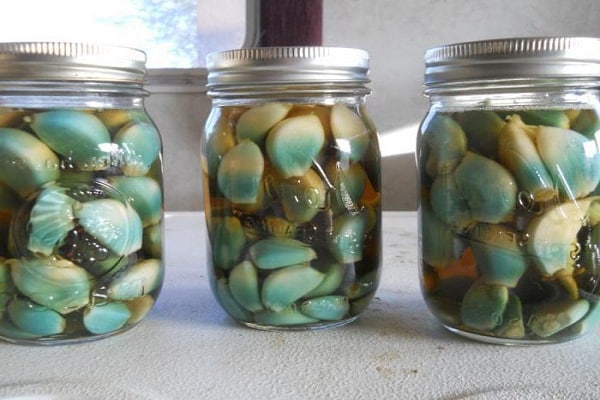
How spices and seasonings affect color change
Some spices and seasonings used in salting can provoke a blue-green, dark gray hue. Similar phenomena tend to occur when added to conservation:
- cinnamon;
- carnations;
- ground black pepper.
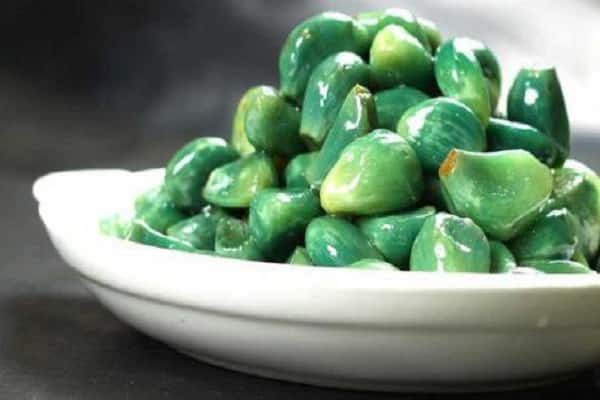
Mixtures consisting of several varieties of spices, seasonings, and spicy vegetables can affect the color of a vegetable. In such cases, a chemical process occurs, consisting in the interaction of various ingredients in the dish.
It is important to understand that herbal spices and seasonings contain natural dyes that are not harmful to humans.
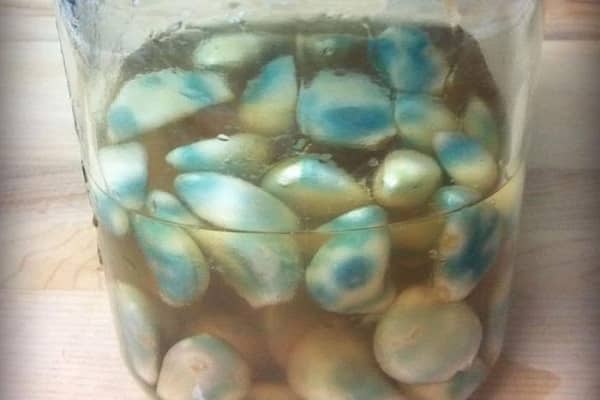
Is it possible to eat blue garlic
Despite the discoloration of the garlic, you can eat it without any fear. An example is many countries around the world where the blue or greening of this vegetable is not perceived as a cause for concern.
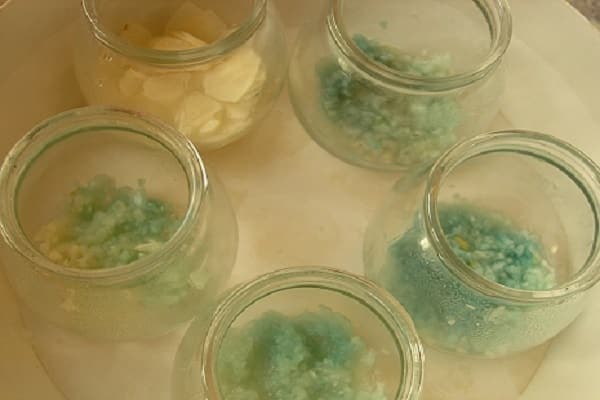
To calm down the flavorful vegetable lovers and allay concerns about the unsuitability of blue garlic, experts report the following. Alliin, present in garlic, initiates the formation of allicin. This substance exhibits the strongest anti-cancer, immunostimulating and bactericidal properties.
Blue garlic indicates an increased content of aliin, and, accordingly, a high degree of usefulness for the body. Based on the foregoing, we can conclude that a vegetable that has changed its usual color as a result of conservation is not at all dangerous for consumption, and can bring no less health benefits in comparison with traditionally light garlic.
Scientists say that the blue that occurs on garlic as a result of pickling is mainly of aesthetic value and does not indicate a high content of nitrates or other harmful chemical compounds in the product. The substances present in the vegetable are absolutely harmless even after unusual changes have occurred to them.
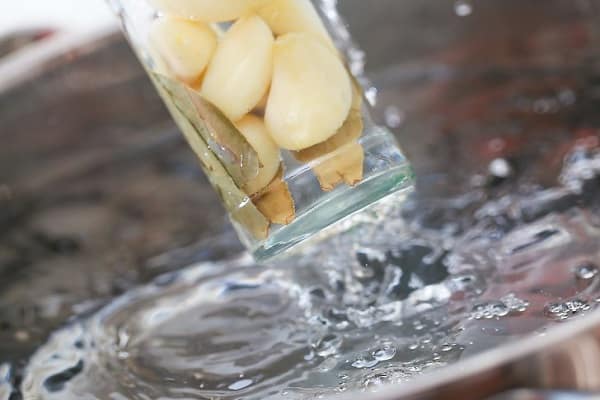
What to do to avoid blue garlic
If the unusual color of garlic in jars of tomatoes or other vegetables still raises concerns, you can use the recommendations to avoid this phenomenon. To reduce the likelihood of a flavored vegetable turning blue, you must:
- Purchase a product grown in domestic conditions. Garlic heads, originating from southern latitudes, have a large number of enzymes responsible for their intense color when pickled.
- For salting use immature, young specimens. An old vegetable that has been stored for a long time has a high concentration of alliin, and its pigmentation often becomes inevitable.
- Do not damage the vegetable teeth. Most of the garlic cloves acquire a blue-green hue, on the surface of which there are cuts and other damage. To reduce the risk of "injury" to the vegetable, it is recommended to avoid using a knife, and to carry out all actions manually.
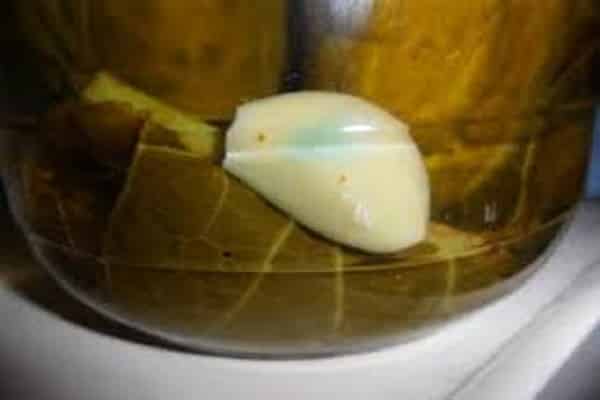
Storing garlic in certain temperature conditions helps to resist blue discoloration. If the vegetable is located in a room with a temperature of +20 to +25 degrees, there is no active accumulation of alliin in it. The situation changes dramatically if the garlic heads are stored at low temperatures (within 1-5 degrees Celsius).
In this case, the substance that leads to the appearance of blue or green spots is produced much more intensively.
It is important to know - when the preservation is already prepared, it should be stored at a low temperature. Under such conditions, the garlic, most likely, will not turn blue, and will retain the most natural color until the cans with the prepared products are opened.

The best option is to perform preservation with freshly picked vegetables. It has been noticed that the use of such a product in most cases does not lead to the appearance of an atypical bluish or greenish color.
Choosing garlic correctly
Before purchasing garlic, you should find out where it comes from. If a vegetable is grown in warm climates, the chances of it changing color after processing are much greater. To avoid blue discoloration or greening of garlic marinated with cucumbers or tomatoes, it is worth purchasing a domestic product grown in moderate climatic conditions.
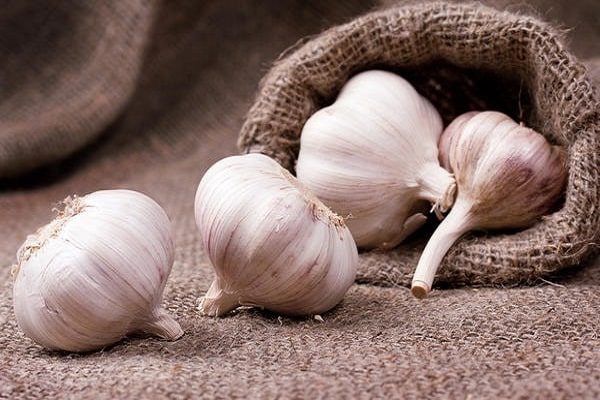
When buying garlic, you should proceed as follows:
- pay attention to the hardness of the vegetable - when you press on a quality product, no dents remain on its surface (lethargic or soft specimens should be discarded);
- choose small, dry heads of garlic - they have a more delicate taste, and are considered the most successful seasoning option (the presence of moisture indicates that the vegetable has been stored improperly for a long time and begins to rot);
- avoid purchasing sprouted garlic - the taste of such cloves is often harsh and slightly unpleasant, and most of the beneficial properties are absent.
By following such simple recommendations, you can avoid the blue discoloration of garlic cloves in jars, and get a tasty and healthy preparation for the winter.

How to pickle properly so that garlic retains its color
To prevent pickled garlic from turning blue, during the harvesting process it is recommended:
- choose young, not fully ripe garlic heads;
- peel the vegetable partially, without touching the elastic skin adjacent to the cloves;
- leave the tails and tips of the slices intact.
Using the dry method helps to avoid blue discoloration. During the preservation of the heads or slices, without adding other vegetables, the product is placed in clean sterile jars (or wooden containers), sprinkled with salt and spices (brine is not used).

In the process of preparing vegetable pickles, the use of cold saline is recommended. The use of boiling water does not preserve the color of the garlic cloves and may lead to the appearance of blue or greenish pigmentation.
A simple recipe for making the marinade, described below, will help to avoid the blue discoloration of the garlic product. It can be used for harvesting all types of salted vegetables.
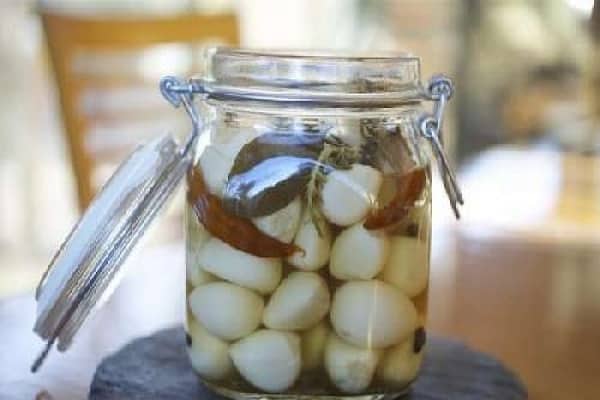
You should have at hand:
- heads of garlic - 10 pcs.;
- hot pepper - 3-4 pods;
- laurel leaves - 2-3 pcs.;
- vinegar - 2 tbsp. l .;
- sugar, salt - 30 g each;
- black peppercorns.
Garlic cloves are gently peeled. Next, the pepper is finely chopped. Both products are thoroughly washed with a hot solution (2 l of water + 2 tbsp. L. Salt).
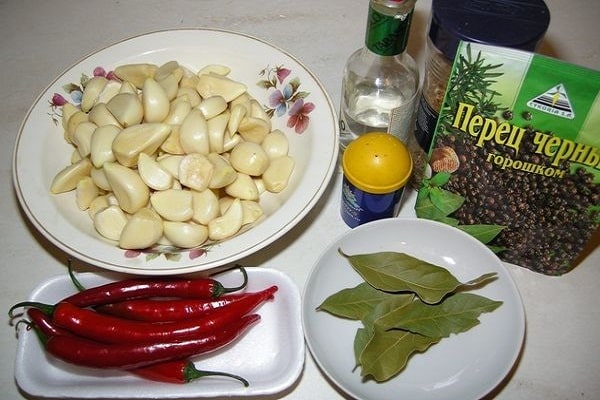
The next step is to prepare the marinade. Bay leaves, 10 black peppercorns, salt, sugar, spices are added to 700-800 ml of water. The mixture is brought to a boil and cooled until warm. Next, the vegetables are laid out in sterilized jars, poured with marinade, and tightly rolled up with lids. The containers are turned upside down, left to cool.
The finished preserves should be stored in cool, dark corners of the house. Vegetables will be completely marinated after 2 weeks.
If all the points are correct, there is no chance that the garlic will change its color. The low temperature of the brine used for canning vegetables will prevent the decomposition of alliin, and the product itself will not lose its appetizing appearance.
